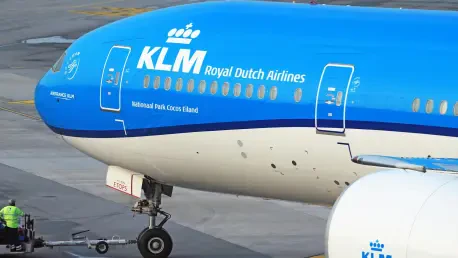Unveiling the Air France-KLM Data Breach Incident
Imagine a scenario where millions of travelers, trusting their personal details with renowned airlines, suddenly face the risk of those details falling into the wrong hands. This became a harsh reality for customers of Air France and KLM, part of the Air France-KLM Group, when a significant data breach compromised sensitive information through a third-party platform integral to their customer service operations. The incident not only exposed vulnerabilities in the aviation sector but also raised pressing concerns about data security in an era where digital reliance is paramount.
Central to this breach are critical questions about its nature, the specific data accessed, and the ripple effects on both the industry and consumer trust. Unlike breaches directly targeting internal systems, this event underscores a pervasive yet often overlooked threat: the susceptibility of third-party systems. As businesses increasingly depend on external providers for operational efficiency, the potential for such incidents grows, demanding a closer examination of how these partnerships can become weak links in the security chain.
The challenge of third-party vulnerabilities stands as the focal point of this incident. While Air France and KLM are not isolated in facing such risks, their experience serves as a stark reminder of the broader implications for data protection across sectors. This breach prompts a deeper inquiry into how organizations can safeguard against threats that originate beyond their immediate control, setting the stage for a detailed exploration of the event and its consequences.
Background and Context of the Breach
The Air France-KLM Group, a leading entity in the global aviation industry, operates as a powerhouse with a vast network of flights and a customer base spanning continents. Like many large corporations, the group relies heavily on third-party platforms to manage essential functions such as customer service, ticketing, and loyalty programs. This dependency, while streamlining operations, introduces inherent risks, as external systems may not always align with the stringent security measures of the primary organization.
Understanding such incidents is vital in today’s digital age, where data breaches have become alarmingly frequent across industries. The reliance on third-party providers is a growing trend, evident not just in aviation but also in retail, technology, and finance, where similar lapses have exposed sensitive information. These events highlight a critical gap in cybersecurity, emphasizing the need for robust oversight and standardized protocols to mitigate risks stemming from external dependencies.
Beyond the technical aspects, this breach connects to broader societal concerns about privacy and trust in large organizations. As consumers entrust personal data to companies for convenience and tailored services, incidents like this erode confidence and raise questions about accountability. The Air France-KLM case thus serves as a microcosm of a larger struggle to balance operational efficiency with the imperative to protect customer information in an interconnected world.
Details of the Breach, Response, and Wider Impact
Discovery and Immediate Response
The breach came to light when the IT security teams at Air France and KLM identified unauthorized access on an external platform used for customer service interactions. Swift action followed, with the airlines collaborating closely with the third-party provider to halt the intrusion and deploy preventive measures to secure the affected system. This rapid response was crucial in containing the damage and preventing further unauthorized access.
Importantly, the internal systems of both airlines remained untouched, ensuring that core operations were not disrupted. The data accessed during the breach included customer names, contact details, and specific information related to Flying Blue accounts, such as membership numbers and tier levels. While no highly sensitive data like passwords or credit card information was compromised, the exposed details still posed significant risks for affected individuals.
The coordinated effort between the airlines and the third-party provider demonstrated a commitment to addressing the issue promptly. However, the incident also exposed the limitations of relying on external systems, where security protocols may vary widely. This initial response, though effective in stopping the breach, marked only the beginning of a broader effort to manage the fallout and rebuild trust.
Customer Impact and Notifications
In the aftermath, Air France and KLM prioritized transparent communication with their customers, issuing warnings about the potential for phishing attempts using the stolen data. These fraudulent messages, often crafted to appear legitimate, could exploit the compromised information to deceive individuals into revealing more sensitive details. The airlines expressed sincere regret for the inconvenience caused, acknowledging the distress such incidents can provoke.
As part of their regulatory obligations, the incident was reported to data protection authorities in both the Netherlands and France, ensuring compliance with strict privacy laws in the European Union. This step underscored the seriousness with which the airlines approached the breach, aligning with legal frameworks designed to protect consumer rights. Customers were urged to remain vigilant, scrutinizing any suspicious communications claiming to originate from the airlines.
The focus on customer notifications highlighted a proactive stance in mitigating risks, though it also revealed the challenges of managing public perception during a security lapse. The potential misuse of personal data for phishing underscored the indirect yet significant impact of the breach. This communication effort aimed to empower customers with knowledge, equipping them to safeguard themselves against secondary threats.
Broader Industry Implications
This incident at Air France and KLM fits into a troubling pattern of data breaches stemming from third-party platform vulnerabilities, affecting a wide array of organizations. Luxury retailers like Dior and Chanel, tech giants like Google, and other airlines such as Qantas have all reported similar lapses, pointing to a systemic issue that transcends industry boundaries. The commonality lies in the exploitation of external systems, often less fortified than internal ones.
Suspicion has fallen on cybercrime groups such as ShinyHunters, known for targeting third-party platforms in high-profile attacks, and Scattered Spider, which has recently shifted focus to the aviation sector. While no definitive attribution has been made in the Air France-KLM case, the involvement of such sophisticated actors suggests a persistent and evolving threat landscape. Their tactics exploit gaps in partner security, amplifying the risks for even the most prepared organizations.
The widespread nature of these breaches signals an urgent need for industry-wide solutions to address third-party risks. As diverse sectors grapple with similar challenges, the incident serves as a reminder that cybersecurity is a collective responsibility. The lack of specific details about the compromised platform in many cases, including this one, further complicates efforts to pinpoint and resolve underlying vulnerabilities, highlighting a critical area for improvement.
Reflection and Future Directions
Reflection on the Incident
Analyzing the Air France-KLM breach reveals the inherent difficulties in securing third-party systems, which often operate outside the direct control of the primary organization. Despite these challenges, the airlines’ swift response in identifying the breach, halting unauthorized access, and implementing safeguards demonstrated a commendable level of preparedness. Their actions helped limit the scope of the damage, protecting more sensitive data from exposure.
Equally notable was the emphasis on customer communication, ensuring that those affected were informed and advised on protective measures against phishing. However, the lack of transparency regarding the identity of the third-party provider involved raises questions about accountability and the reasons for such discretion. This opacity could stem from a desire to preserve business relationships or from uncertainties about the full extent of the breach.
Reflecting on this event, it becomes clear that while proactive measures can mitigate immediate harm, they do not fully address the root causes of third-party vulnerabilities. The incident underscores a broader tension between operational reliance on external partners and the imperative to maintain stringent security standards. This balance remains a critical challenge for organizations navigating the complexities of modern data ecosystems.
Future Directions for Data Security
To prevent similar breaches, there is a pressing need for stronger vetting processes when selecting third-party partners, ensuring that their security practices align with industry best practices. Establishing rigorous standards and conducting regular audits could help identify potential weaknesses before they are exploited. Such measures would create a more resilient framework for collaboration, reducing the likelihood of data exposure through external channels.
Additionally, further research into the evolving tactics of cybercrime groups is essential to stay ahead of emerging threats. Understanding how groups like ShinyHunters adapt their methods can inform the development of more effective countermeasures. This knowledge could guide the creation of predictive tools and proactive defenses, equipping organizations to anticipate and neutralize attacks before they materialize.
Finally, the development of industry-wide frameworks for data protection offers a path toward collective security. By fostering collaboration across sectors, such initiatives could standardize security expectations for third-party providers, addressing systemic vulnerabilities. This unified approach would not only benefit individual companies but also enhance trust in the broader digital landscape, ensuring safer interactions for all stakeholders.
Conclusion: Lessons Learned and the Path Forward
Looking back, the Air France-KLM data breach served as a critical lesson in the pervasive threat posed by third-party vulnerabilities, exposing customer data through an external platform. It highlighted the risks inherent in modern business dependencies, even as internal systems remained secure. The incident also underscored the potential for secondary threats like phishing, necessitating heightened customer awareness.
Moving forward, actionable steps emerged as a priority to bolster data security. Organizations must invest in comprehensive vetting and continuous monitoring of third-party partners, ensuring alignment with robust security protocols. Collaborative efforts to establish cross-industry standards could further fortify defenses, creating a united front against cyber threats.
Beyond immediate solutions, fostering innovation in cybersecurity practices stands as a vital consideration. Encouraging the adoption of advanced technologies and sharing insights on emerging threats can empower companies to stay resilient. Ultimately, safeguarding data in an interconnected world demands a commitment to evolving strategies, ensuring that trust and privacy remain paramount for customers navigating the digital realm.









